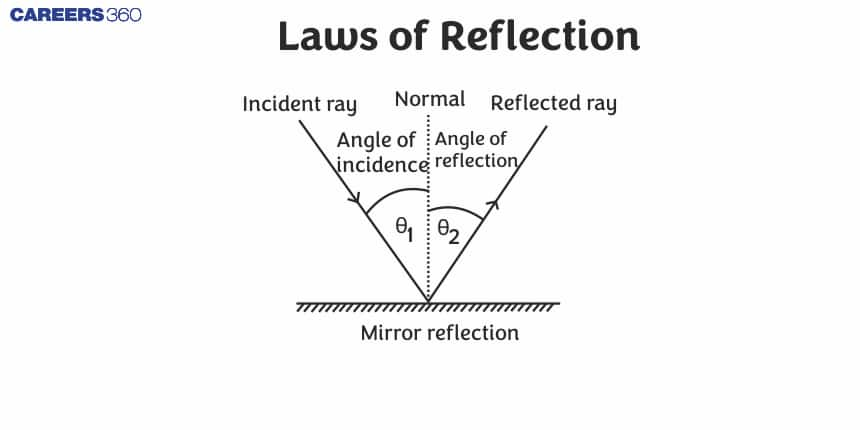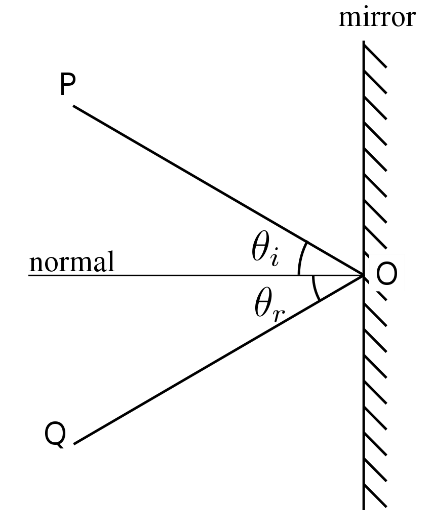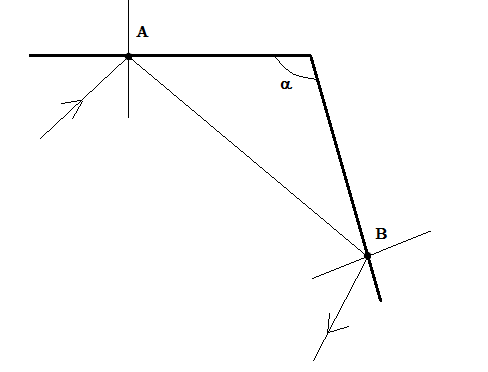Laws of Reflection - Definition, Diagram, Examples, FAQs
Have you ever noticed when you look at the mirror and see your face as clear as a picture? This is because the process of reflection takes place. For example, when light falls on a mirror, it reflects from it as it can penetrate it. This bouncing back of light is called reflection. Reflection in Physics is also applied in many things seen in daily life such as cameras, periscopes, or in viewing how light or sound functions. Let's explore the concept of reflection in detail.
JEE Main/NEET 2027: Physics Important Formulas for Class 10
NEET 2025: Mock Test Series | Syllabus | High Scoring Topics | PYQs
JEE Main: Study Materials | High Scoring Topics | Preparation Guide
JEE Main: Syllabus | Sample Papers | Mock Tests | PYQs
- What is Reflection?
- Laws of Reflection
- Types of Reflection
- Application of Reflection
- Solved Examples on Reflection

What is Reflection?
The phenomenon when a ray of light strikes an opaque surface, it bounces back instead of passing through it is called reflection. We can see objects and images in mirrors or on reflective surfaces with the help of reflection.

Laws of Reflection
There are two laws of reflection that help to describe how light reflects off surfaces. These laws are:
- The Angle of Incidence Equals the Angle of Reflection: It states that the angle at which the ray strikes is equal to the angle at which it reflects. Mathematically it is represented as:
- The Incident Ray, the Reflected Ray, and the Normal Lie in the Same Plane: The striking ray ( incident ray), the ray that is bouncing off the surface (reflected ray) and the perpendicular to the surface all lie in the same plane.
Also read -
- NCERT Notes For All Subjects
- NCERT Solutions for All Subjects
- NCERT Exemplar Solutions for All Subjects
Types of Reflection
- Regular (Specular) Reflection
- Irregular (Diffuse) reflection
Regular (Specular) Reflection: Regular Reflection occurs when light falls on a smooth surface and as a result, it creates a clear, and sharp image. The reflected rays are parallel to each other.
This smooth surface can be a mirror. A mirror is made of glass coated with a reflective material. This reflective material helps in reflecting light incident on it uniformly.
Example: Reflection in a plane mirror.
Irregular (Diffuse) reflection: When light falls on an uneven surface, it scatters in different directions, and as a result, no clear image is formed. This type of reflection is called Irregular reflection. This uneven surface can occur due to scratches, wear and tear, dirt on the surface, or due to the material of the surface.
The difference between regular and irregular reflection
|
S. No.
|
Regular Reflection
|
Irregular Reflection
|
| 1 | When all reflected rays from a smooth surface are parallel to incident rays. | This is when incident parallel rays do not remain parallel to each other, the reflected rays do. |
| 2 | Smooth surfaces, such as mirrors, silver spoons, etc. provide this texture. | Rusty surfaces such as wood, doors, tables, books, etc. provide this texture. |
|
Related Topics |
Application of Reflection
- Periscopes use reflection to observe advancing enemies on the battlefield from a safe distance.
- We see objects because of reflections.
- Mirrors with concave and convex lens surfaces can reflect a variety of different images.
- Medical diagnostics rely on reflection, as does optical path communication.
- The law of reflection governs both light and sound, as both are waves.
- Our ability to measure distances accurately to objects is based on the law of reflection for sound and light.
- The echoes of sound are the result of reflections.
Solved Examples on Reflection
Q1. An incident ray of light strikes a plane mirror at an angle of
Solution:
The angle of incidence is determined by comparing the incident ray with the normal, so it is not 60° in this case
Following the Law of reflection,
Hence,
The angle of reflection

Q2: Determine the angle * which would be made by the system of the two mirrors shown in the figure below so that A and B are parallel to one another.

Solution:
Here is a diagram in which we fill in the angles of incidence and reflection and also label the rays as they are incident and reflected.
Angles I + r and i' + r’, which represent the incident wave at A and the reflected wave at B, have to be supplementary. (Geometry: cross-section cut between parallel lines).
Therefore,
As a result of the law of reflection,
Substitute to obtain
In triangle
If
Frequently Asked Questions (FAQs)
Periscopes use reflection to observe advancing enemies on the battlefield from a safe distance.
We see objects because of reflections.
The light is reflected back into the denser medium when it passes from a denser medium to a lighter medium at an angle greater than the critical angle for refraction. Total Internal Reflection refers to this phenomenon.
Objects beyond the focus of a concave mirror give real, inverted images. Objects within the focal range of a concave mirror give a virtual, erect, enlarged image.
It is known as the reflection of light when light rays hit the surface and bounce back.
A smooth surface is defined as having an angle equal to that of the reflected ray on reflection. The angle is equal to the angle between the incident and reflected rays that is parallel to the line perpendicular to the surface at the point of contact.
Also Read
19 Jul'25 03:20 PM
02 Jul'25 07:56 PM
02 Jul'25 06:11 PM
02 Jul'25 05:17 PM
02 Jul'25 05:09 PM
02 Jul'25 05:08 PM
02 Jul'25 05:08 PM
02 Jul'25 05:07 PM
02 Jul'25 05:07 PM
02 Jul'25 05:04 PM


